Layman D. Biology Demystified: A Self-Teaching Guide
Подождите немного. Документ загружается.

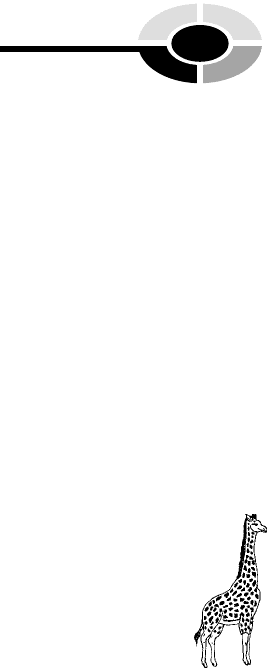
holes. The red bone marrow is red in color mainly due to the fact that it
consists of many blood vessels. These dozens of blood vessels run and branch
extensively throughout the holes of the spongy bone. Their main function is
that of hematopoiesis (he-muh-toh-poi-E-sis) – the process of ‘‘blood’’
(hemat) ‘‘formation’’ (-poiesis). Most of the blood cells (and blood cell frag-
ments) ultimately are formed by hematopoiesis occurring within the red bone
marrow. The blood cells enter the general bloodstream when they are circu-
lated out of the long bone, through the vessels leaving the red bone marrow.
Bone Development, Bone Matrix, and Blood
Calcium Homeostasis
Besides hematopoiesis and protection from physical trauma, another critical
function of the endoskeleton is blood calcium homeostasis; that is, the main-
tenance of a relatively constant blood calcium ion concentration.
Symbolically speaking, we use Ca
þþ
to identify blood calcium ions, and
brackets, [ ], to denote concentration. Thus, we have [Ca
þþ
] to indicate the
blood calcium ion concentration.
The blood calcium ion concentration, [Ca
þþ
], within humans, is usually
measured in units of mg/dL – milligrams (MIH-lih-grams) of calcium ions per
deciliter (DEH-sih-lee-ter) – of blood. A deciliter is one-‘‘tenth’’ (deci-)ofa
‘‘liter.’’ And milligrams is a unit representing the number of ‘‘thousandths’’
(milli-) of a ‘‘gram’’ of some substance. Hence, blood [Ca
þþ
] in mg/dL
denotes the number of milligrams of calcium ions present within one-tenth
of a liter of blood. The normal or reference range for blood [Ca
þþ
] is from a
low of about 8.5 to a high of approximately 10.6 mg Ca
þþ
/dL of blood (in
adults). Taking the same approach we employed for thermoregulation
(Figure 13.2), we can use the S-shaped pattern, once again, to represent
the homeostasis of blood calcium ion concentration, over time (see Figure
13.6). In naming this particular pattern of chemical concentration, we use the
suffix, -emia (‘‘blood condition of ’’), and the root or main idea, calc
(‘‘calcium’’). We therefore have some form of calcemia (kal-SEE-me-uh),
or ‘‘condition of calcium’’ (ion concentration) within the ‘‘blood.’’ [Study
suggestion: Using the same prefix as that employed to describe the normal-
range body temperature pattern of Figure 13.2, name the blood calcium ion
concentration pattern symbolized by Figure 13.6, below. When you are done
building this term, check it with the correct term found in the caption for
Figure 13.6.]
CHAPTER 13 Skins and Skeletons 227
[13:25 13/6/03 N:/4058 LAYMAN.751/4058-Alltext.3d] Ref: 4058 Layman: Biology Demystified All-text Page: 227 1-388
5, Order
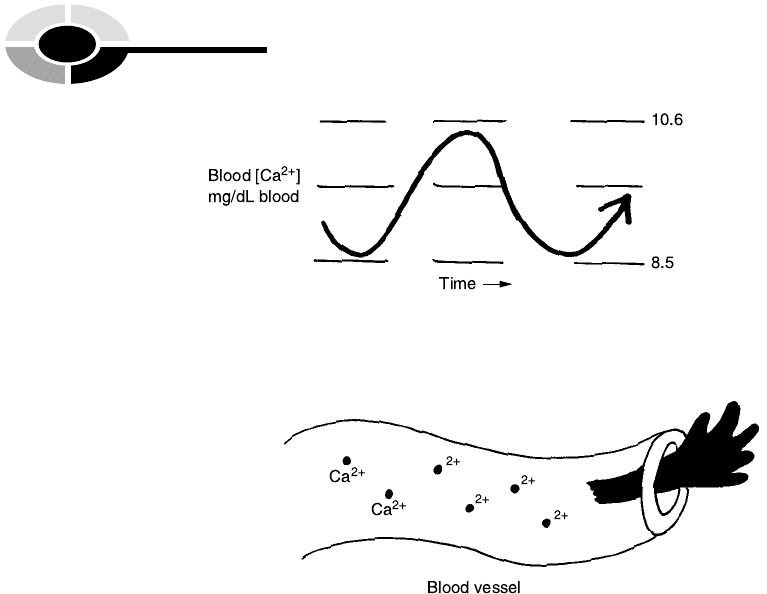
Bone development and bone matrix
‘‘How is normocalcemia related to bone development and bone matrix?’’ you
might well ask at this time. The answer is provided by a close look at Figure
13.7. During the development of a long bone, such as the femur (‘‘thigh’’
bone), the process essentially begins with a cartilage model – a miniature
version of the bone that is composed of cartilage, rather than bone tissue.
Being soft and rubbery, cartilage is more suitable for life within the mother’s
uterus (womb). As development progresses, however, blood vessels break
into the cartilage model and bring osteoblasts (AHS-tee-oh-blasts) along
with them. Osteoblasts are literally ‘‘bone’’ (oste) ‘‘formers’’ (-blasts).
The osteoblasts are large, spider-shaped cells that produce bone collagen
fibers. After these tough collagen fibers are laid down, the osteoblasts then
extract Ca
þþ
ions, phosphorus, and other chemicals from the bloodstream.
Ossification (ah-sih-fih-KAY-shun), the ‘‘process of bone formation,’’ then
begins. During ossification, the osteoblasts supervise the depositing of
sharp, needle-shaped crystals onto the surfaces of the bone collagen fibers.
These sharp crystals are composed of calcium phosphate (FAHS-fate), as well
[13:25 13/6/03 N:/4058 LAYMAN.751/4058-Alltext.3d] Ref: 4058 Layman: Biology Demystified All-text Page: 228 1-388
PART 4 Anatomy and Physiology of Animals
228
Fig. 13.6 Maintenance of normocalcemia over time.
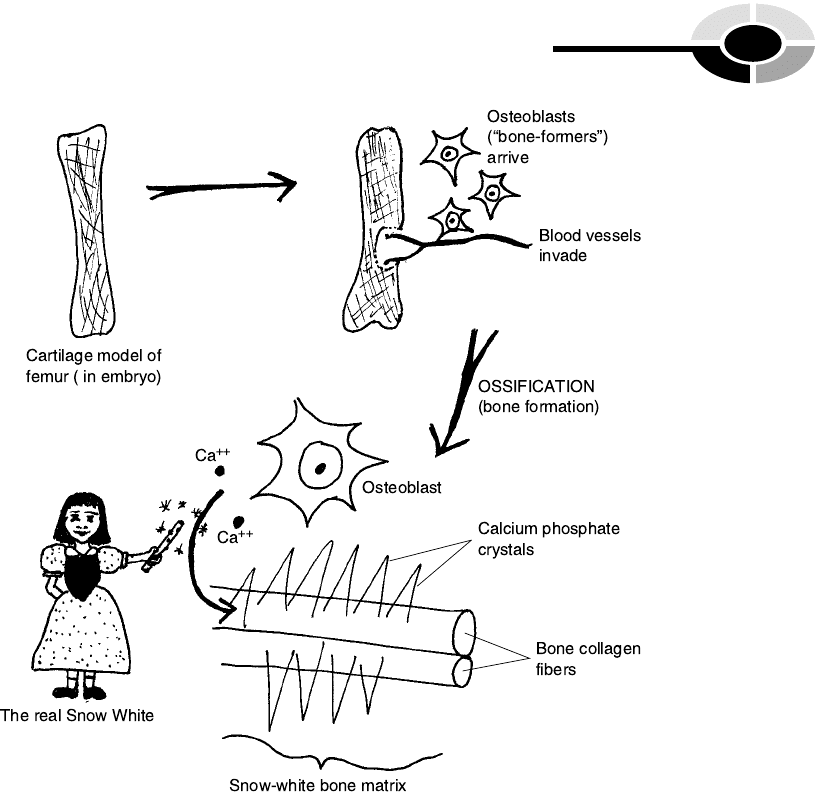
as a number of other minerals. Essentially, bone matrix appears within the
cartilage model of the long bone, because the newly produced bone collagen
fibers become heavily coated with the calcium phosphate crystals. Being
snow-white, these crystals eventually hide the underlying collagen fibers.
Viewed with the naked eye, the entire bone matrix thus appears snow-
white. The bone matrix is white, like cement, of course, because white is
the color of the many thousands of calcium crystals covering the collagen
fibers in the matrix.
By the time the child becomes an adult, her femur is mostly snow-white.
You might think of all the bone matrix in the femur as essentially being a
storage bank for calcium ions.
CHAPTER 13 Skins and Skeletons 229
[13:25 13/6/03 N:/4058 LAYMAN.751/4058-Alltext.3d] Ref: 4058 Layman: Biology Demystified All-text Page: 229 1-388
Fig. 13.7 Bone matrix appears during ossification.
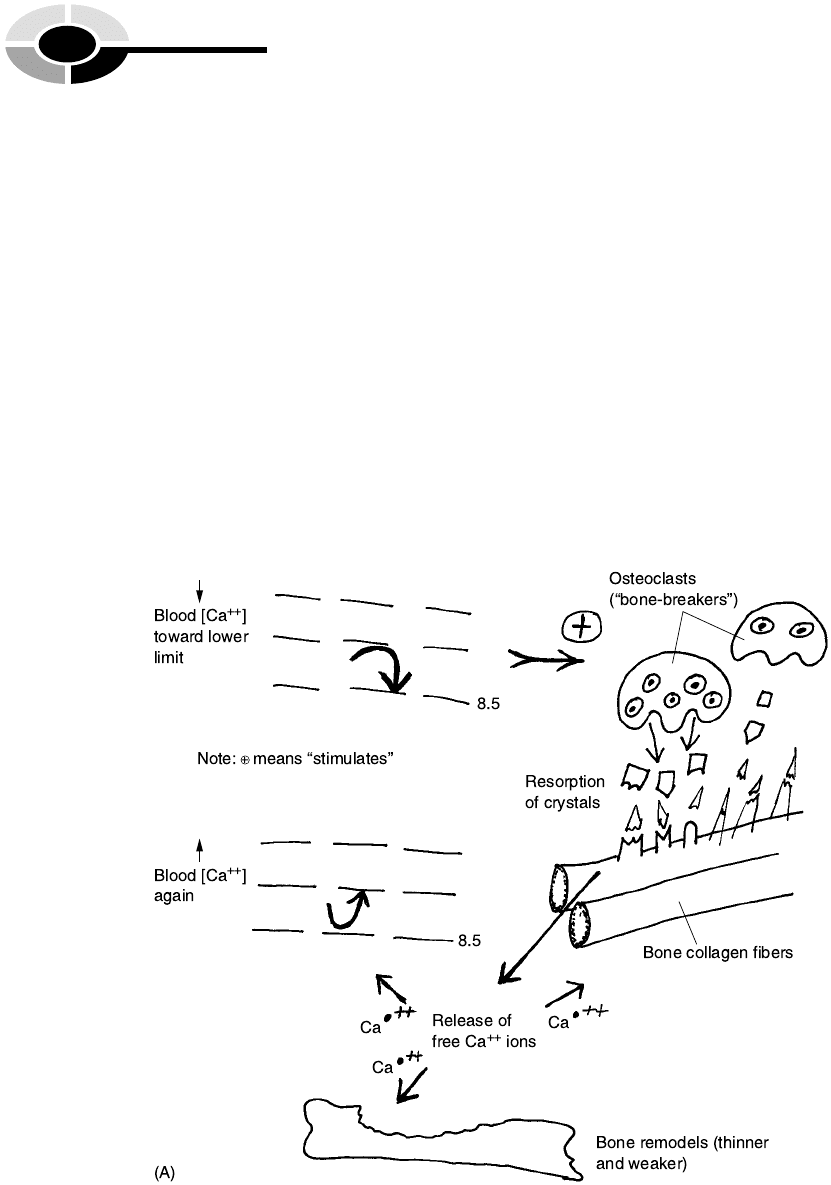
BONE REMODELING AND MAINTENANCE OF BLOOD
CALCIUM HOMEOSTASIS
Just as osteoblasts are ‘‘bone-makers,’’ cells called osteoclasts (AHS-tee-oh-
klasts) are ‘‘bone-breakers’’ (-clasts). By bone-‘‘breakers,’’ of course, we don’t
literally mean that these osteoclast cells actually break or fracture the bone!
Rather, we mean that the osteoclasts release special digestive enzymes that
cause a partial resorption (rih-SORP-shun) or ‘‘drinking-in again’’ of the bone
matrix, such that some of the calcium phosphate crystals are dissolved back
into calcium and phosphate ions. Such a process often occurs whenever the
blood [Ca
þþ
] falls toward the lower limit of its normal range (Figure 13.8, A).
And as a result of this resorption (dissolving or ‘‘drinking-in again’’) of bone
matrix, Ca
þþ
ions that were formerly stored in the bone matrix, like a bank,
are now released back into the blood circulation. This process, quite clearly,
acts to temporarily raise the blood [Ca
þþ
]. Because the bone gets thinner and
weaker, we say it has remodeled – changed its thickness and strength.
[13:25 13/6/03 N:/4058 LAYMAN.751/4058-Alltext.3d] Ref: 4058 Layman: Biology Demystified All-text Page: 230 1-388
PART 4 Anatomy and Physiology of Animals
230
Fig. 13.8 Bone-makers, bone-breakers, and blood calcium homeostasis.
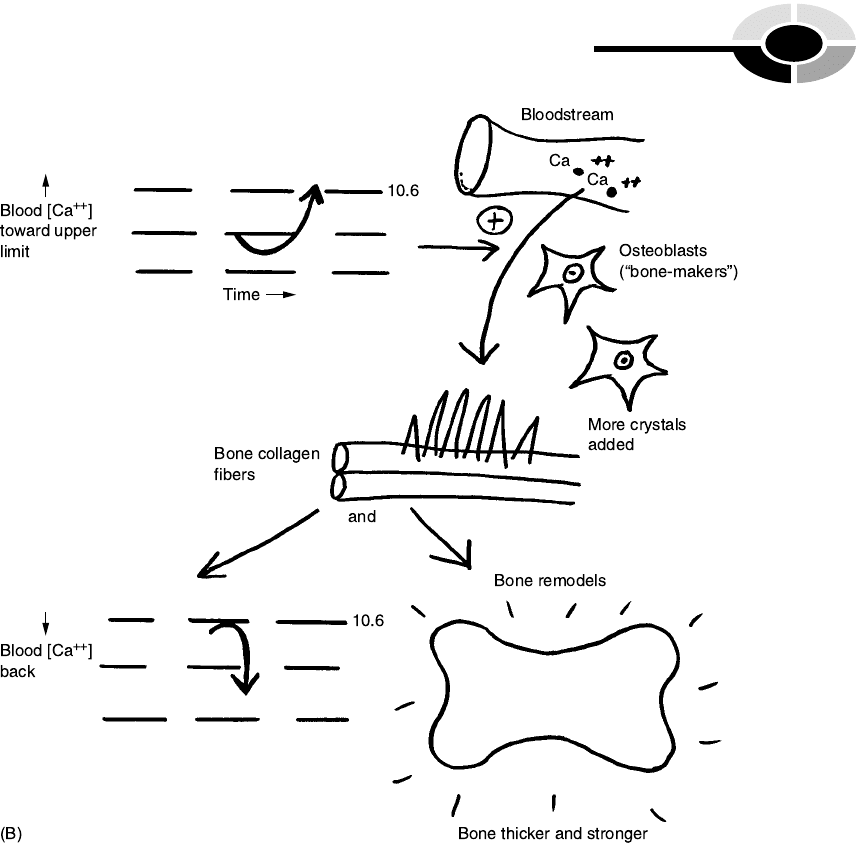
Conversely, whenever a person eats a calcium-rich meal, the blood [Ca
þþ
]
rises toward the upper limit of its normal range (Figure 13.8, B). Thousands
of osteoblasts are stimulated, then more Ca
þþ
ions are extracted from the
bloodstream and laid down on the bone collagen fibers as calcium phosphate
crystals. The bone once again remodels (changes its shape and size), but this
time it goes in the opposite direction, by getting thicker and stronger. And as
more and more free Ca
þþ
ions are extracted from the bloodstream and put
into calcium phosphate crystals, the blood [Ca
þþ
] falls.
By these contrasting processes involving osteoblasts, osteoclasts, bone
remodeling, and bone resorption, therefore, homeostasis of blood [Ca
þþ
]is
usually maintained. Maintaining a normal blood [Ca
þþ
] is critical for human
CHAPTER 13 Skins and Skeletons 231
[13:25 13/6/03 N:/4058 LAYMAN.751/4058-Alltext.3d] Ref: 4058 Layman: Biology Demystified All-text Page: 231 1-388
Fig. 13.8 (continued)
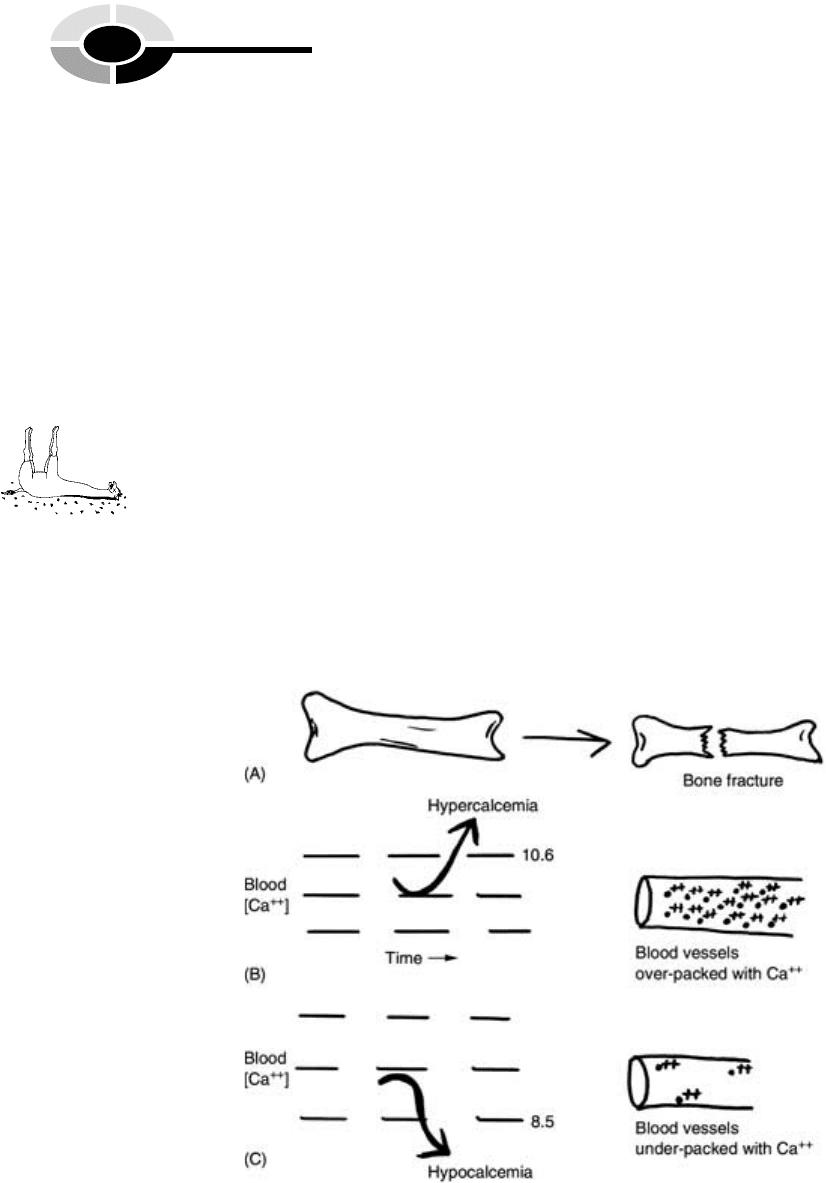
health. Why? One reason is that the contractions of all our body muscles
(including those of the heart) require an adequate level of calcium ions within
the bloodstream.
Breaking of Bone-related Patterns
We can think of the normal anatomy of a long bone (such as the femur) as an
example of Biological Order at the organ level of body organization. And
blood [Ca
þþ
] homeostasis likewise provides a model of Biological Order at
the chemical level of biological organization (Chapter 2).
What, then, about Biological Disorder for the above examples? What,
specifically, could go wrong with each of them? A long bone could suffer a
fracture (Figure 13.9, A), thereby breaking its normal anatomical pattern.
And blood [Ca
þþ
] could rise far above its normal range (Figure 13.9, B).
Conversely, it could fall far below its normal range (Figure 13.9, C). [Study
suggestion: Using the term, normocalcemia, along with an appropriate prefix,
build a term that describes the blood [Ca
þþ
] in Figure 13.9, (B); now build
[13:25 13/6/03 N:/4058 LAYMAN.751/4058-Alltext.3d] Ref: 4058 Layman: Biology Demystified All-text Page: 232 1-388
PART 4 Anatomy and Physiology of Animals
232
Fig. 13.9 Breaking some bone-related patterns.
3, Disorder

another term summarizing the blood [Ca
þþ
] in Figure 13.9, C. When done,
check your answers with the terms given in Figure 13.9.]
Joints: A Meeting of the Bones
A junction is a meeting or joining place. (Picture a railroad junction or
crossing of two intersecting train tracks.) A joint, therefore, is a place of
meeting or joining between bones. There are three main types or categories of
joints within the human body (Figure 13.10).
CHAPTER 13 Skins and Skeletons 233
[13:25 13/6/03 N:/4058 LAYMAN.751/4058-Alltext.3d] Ref: 4058 Layman: Biology Demystified All-text Page: 233 1-388
Fig. 13.10 The three main types of joints.

FIBROUS JOINTS (SYNARTHROSES)
The simplest group are the fibrous (FEYE-brus) joints or synarthroses (sin-ar-
THROW-seez). As their name indicates, the adjacent bones in a fibrous joint
are more-or-less strapped together by a set of collagen fibers. A good exam-
ple is provided by the sutures (SOO-churs) or jagged ‘‘seams’’ (sutur) running
between individual skull and facial bones.
The sutures and other types of fibrous joints are immovable. This gives
them the alternate name of synarthroses – literally ‘‘conditions of ’’ (-oses)
‘‘joints’’ (arthr) with the bones strapped ‘‘together’’ (syn-).
CARTILAGINOUS JOINTS (AMPHIARTHROSES)
The next group of joints are called amphiarthroses (am-fee-ar-THROW-seez).
These are ‘‘joint conditions’’ (arthroses) permitting movement ‘‘on both
sides’’ (amphi-) of the involved bones. Amphiarthroses are only partially
movable joints, but (as their name states) their bones can move on both
sides, and in all directions.
Consider, for instance, the intervertebral (in-ter-ver-TEE-bral) joints that
are sandwiched ‘‘between’’ (inter-) the individual vertebrae. Because the
intervertebral joints are slightly movable, you are able to bend your back
and twist your trunk moderately as the jointed vertebrae move short dis-
tances on both of their sides (top and bottom) and in all directions. You may
even be able to dance the ‘‘twist’’!
An oval slab of cartilage connective tissue, called the intervertebral disc,
lies between each two vertebrae and connects the vertebra lying above it to
the one lying below.
Cutting a section out of an intervertebral disc, and looking at it through
the microscope, would reveal a slab of cartilage connective tissue. (Hence the
alternate name, cartilaginous joints.) The cartilage holding the vertebrae
together is shot through with numerous collagen fibers. These fibers make
the oval, disc-shaped slab of cartilage behave much like a stale marshmallow
or tough cushion. Because there are so many intervertebral joints (containing
intervertebral discs) between the vertebrae, the vertebral column has excellent
shock absorption. When you jump up-and-down with excitement, then, you
usually don’t break your back!
[13:25 13/6/03 N:/4058 LAYMAN.751/4058-Alltext.3d] Ref: 4058 Layman: Biology Demystified All-text Page: 234 1-388
PART 4 Anatomy and Physiology of Animals
234

SYNOVIAL JOINTS (DIARTHROSES)
The third main category of joints are the diarthroses (die-ar-THROW-seez)
or synovial (sin-OH-vee-al) joints. The word, diarthrosis (die-ar-THROW-
sis), indicates a ‘‘double’’ (di-) ‘‘joint’’ (arthr) ‘‘condition’’ (-osis). An indivi-
dual is said to be ‘‘double-jointed’’ when the interphalangeal (in-ter-fah-lan-
GEEL) joints ‘‘between’’ (inter-) his ‘‘finger or toe bones’’ (phalange) have an
unusually high degree of mobility. Hence, the diarthroses are the freely
movable joints, with bones so movable that many seem to be double-jointed!
Finally, the word, synovial, ‘‘pertains to’’ (-al) ‘‘eggs’’ (ovi) ‘‘together’’
(syn-). The amusing thinking behind this name reflects the appearance of
the synovial fluid. This fluid is secreted by the synovial membrane lining the
hollow joint cavity. The synovial fluid is clear, thick, and slimy, making it
look like the raw white portion of many eggs poured into a frying pan
together. Due to its slippery nature, the synovial fluid significantly reduces
bone friction and wear while the body carries out most of its major move-
ments.
Quiz
Refer to the text in this chapter if necessary. A good score is at least 8 correct
answers out of these 10 questions. The answers are found in the back of this
book.
1. In general, differentiation is:
(a) The process whereby the individual germ layers in the embryo
eventually become highly specialized
(b) A gradual reduction in complexity of body tissues with increasing
age
(c) Any biological means by which organs become more similar to
each other
(d) A specific type of diffusion of molecules
2. One major reason for studying the skin and skeleton together within
the same chapter:
(a) The skin and bones are both primarily composed of calcium
crystals
(b) Both organ systems remain to help identify an animal after it dies
(c) Because all the other organ systems fit together as one
(d) Purely a matter of random guesswork!
CHAPTER 13 Skins and Skeletons 235
[13:25 13/6/03 N:/4058 LAYMAN.751/4058-Alltext.3d] Ref: 4058 Layman: Biology Demystified All-text Page: 235 1-388

3. Unlike plants, the epidermis of humans and most other animals:
(a) Is rich in keratin proteins
(b) Has adequate reserves of chlorophyll
(c) Participates in photosynthesis
(d) Is located deep (internal) to the actual body surface
4. Dead, waterproof ‘‘scales’’ lying upon the skin surface:
(a) Squamae
(b) Strata
(c) Melanocytes
(d) Granules
5. Collagen fibers are very tough, due to their high:
(a) Elasticity
(b) Tension
(c) Rate of excretion
(d) Tensile strength
6. The skin primarily achieves its thermoregulation through the processes
of _____ and _____:
(a) Sweat evaporation and vasodilation
(b) Radiation and vasoconstriction
(c) Sweat evaporation and cell loss
(d) Radiation and sensory reception
7. Unlike crabs and other arthropods, human beings have:
(a) An exoskeleton
(b) Jointed appendages
(c) An endoskeleton
(d) Chitin in their skin
8. The main shaft of a long bone:
(a) Diaphysis
(b) Spongy spone
(c) Epiphysis
(d) Marrow
9. Hematopoiesis is a critical function of:
(a) Red bone marrow
(b) Cancelli
(c) Yellow bone marrow
(d) Adipose connective tissue
[13:25 13/6/03 N:/4058 LAYMAN.751/4058-Alltext.3d] Ref: 4058 Layman: Biology Demystified All-text Page: 236 1-388
PART 4 Anatomy and Physiology of Animals
236
